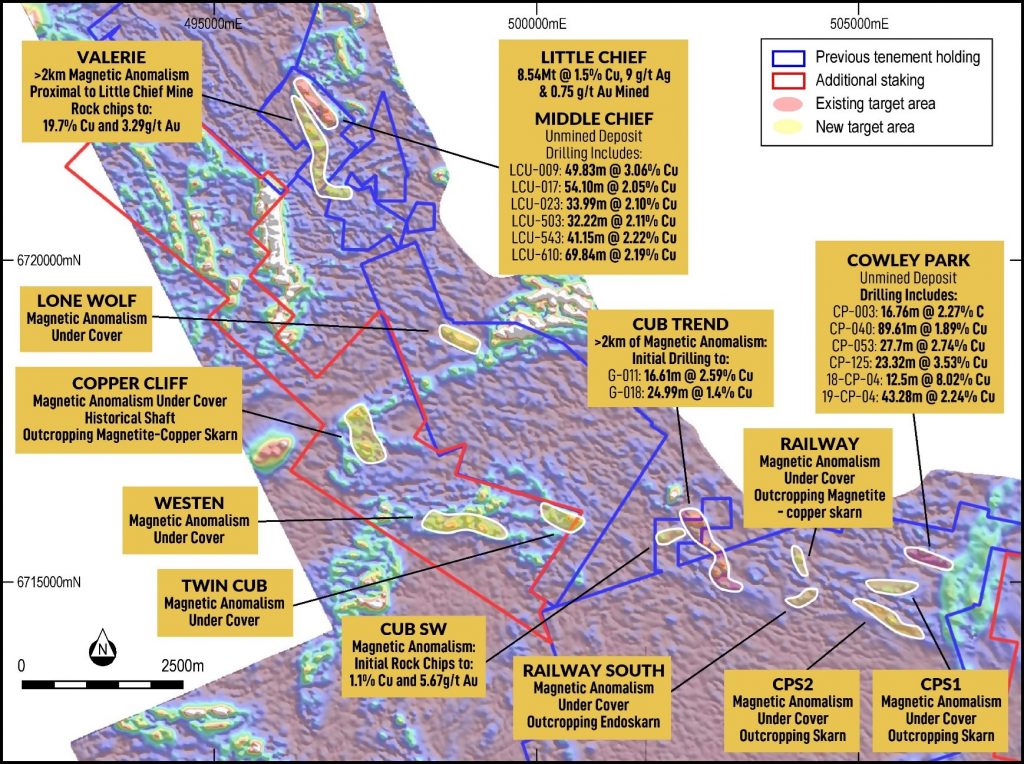
Gladiator Metals (TSXV:GLAD) has announced an update on exploration at the Whitehorse Copper Project, where recently completed drone magnetic surveys have identified multiple, significant, undrilled, large-scale magnetic anomalies along strike of historical mining operations at the Cowley Park and Cub Trend deposits.
Gladiator CEO, Jason Bontempo commented in a press release: “With historical, economic discoveries of copper mineralization in the Whitehorse area largely driven by outcropping occurrences, this first-time survey of its size, coverage and latest technology was designed to explore prospective sections of geology for magnetite-copper skarns hidden under thin cover. Given the high magnetic response of previously identified bodies of magnetite-copper skarn mineralization, Gladiator is confident that this survey can act as a direct detection tool for further zones of high-grade copper mineralization. Multiple, new, undrilled magnetic anomalies have been identified by the survey indicating the extensive new discovery potential of high-grade copper in the Whitehorse Copper Project area. Gladiator’s field crews are now active, on the ground, following up on these identified anomalies and we look forward to updating the market on the developing target areas ahead of drilling later this year.”
The processed results from the high-definition drone-borne aeromagnetic survey completed over the Whitehorse Copper Belt have successfully identified potential extensions to known mineralization, highlighted significant un-drilled exploration targets associated with high-magnetic responses, and supported a strong correlation between occurrences of magnetite-copper skarn mineralization and reported magnetic anomalies.
Gladiator believes that a survey of this detail and extent can be effectively utilized as a direct detection tool for mineralized bodies under cover. The survey results have prompted the company to stake an additional 54 km2 of claims, bringing the total area of the Whitehorse Copper Project to 133 km2.
In response to the acquisition of this significant quality data set and the new staking, Gladiator has advanced its summer field campaigns to immediately commence follow-up on magnetic targets. The company has already begun geological mapping, rock chipping, and soil sampling, with ground-based geophysics (IP and EM) set to commence shortly ahead of planned drilling.
Historical exploration of the Whitehorse Copper Belt was largely driven by the discovery of outcropping zones of copper skarn mineralization, with drilling stepping out from these initial discoveries to determine the size and potential of prospective areas. The recent survey was designed to target areas of prospective geology under the thin glacial tills and glaciofluvial sediments that cover much of the Whitehorse Copper Belt.
The drone magnetics also act as a preliminary geological tool to help map out the contact between the Cretaceous Whitehorse Batholith and the Triassic Lewes Carbonate sediments, which is the primary vector for mineralization in the district. The constraint of this prospective horizon under the thin cover sequences will help to open up multiple new areas for exploration in the coming months and focus Gladiator’s efforts on more prospective targets.
Summer field campaigns have now commenced and will follow up on all identified targets and magnetic anomalies with mapping, rock chipping, and soil sampling, to be shortly followed by ground-based geophysical surveys (IP and EM). These surveys are designed to advance and prioritize target areas ahead of planned drilling campaigns in Q3 2024.
Work completed to date, including the review of the aeromagnetic data received, has identified more than 30 drill-ready, high-grade regional targets associated with copper-rich skarns at the contact between the Cretaceous age Whitehorse Plutonic Suite and the Triassic to Jurassic Lewes River Group’s clastic and carbonate metasediments. Cumulatively, there is more than 35km of underexplored strike on the contact, which is highly prospective for high-grade copper+/-molybdenum+/-silver+/-gold.
Highlights from the results are as follows:
- Gladiator has recently received the processed results from a high-definition drone-borne aeromagnetic survey completed over the Whitehorse Copper Belt, the survey has successfully:
- Identified potential extensions to known mineralization;
- Highlighted significant un-drilled exploration targets associated with high-magnetic responses; and
- Supports a strong correlation between occurrences of magnetite-copper skarn mineralization and reported magnetic anomalies.
- Identified potential extensions to known mineralization;
- The results of the survey supports Gladiator’s belief that a survey of this detail and extent can be utilised effectively as a direct detection tool of mineralized bodies under cover.
- An initial review of the survey has identified significant new target areas associated with high magnetic responses that has driven Gladiator to stake an additional 54 km2 of claims, bringing the total area of the Whitehorse Copper Project to 133 km2
- In response to the acquisition of a significant quality data set and the new staking, Gladiator has advanced its summer field campaigns to immediately commence follow up on magnetic targets having already commenced geological mapping, rock chipping and soil sampling with ground-based geophysics (IP and EM) to commence shortly ahead of planned drilling.



 Follow us on Twitter
Follow us on Twitter Become our facebook fan
Become our facebook fan










Comments are closed.